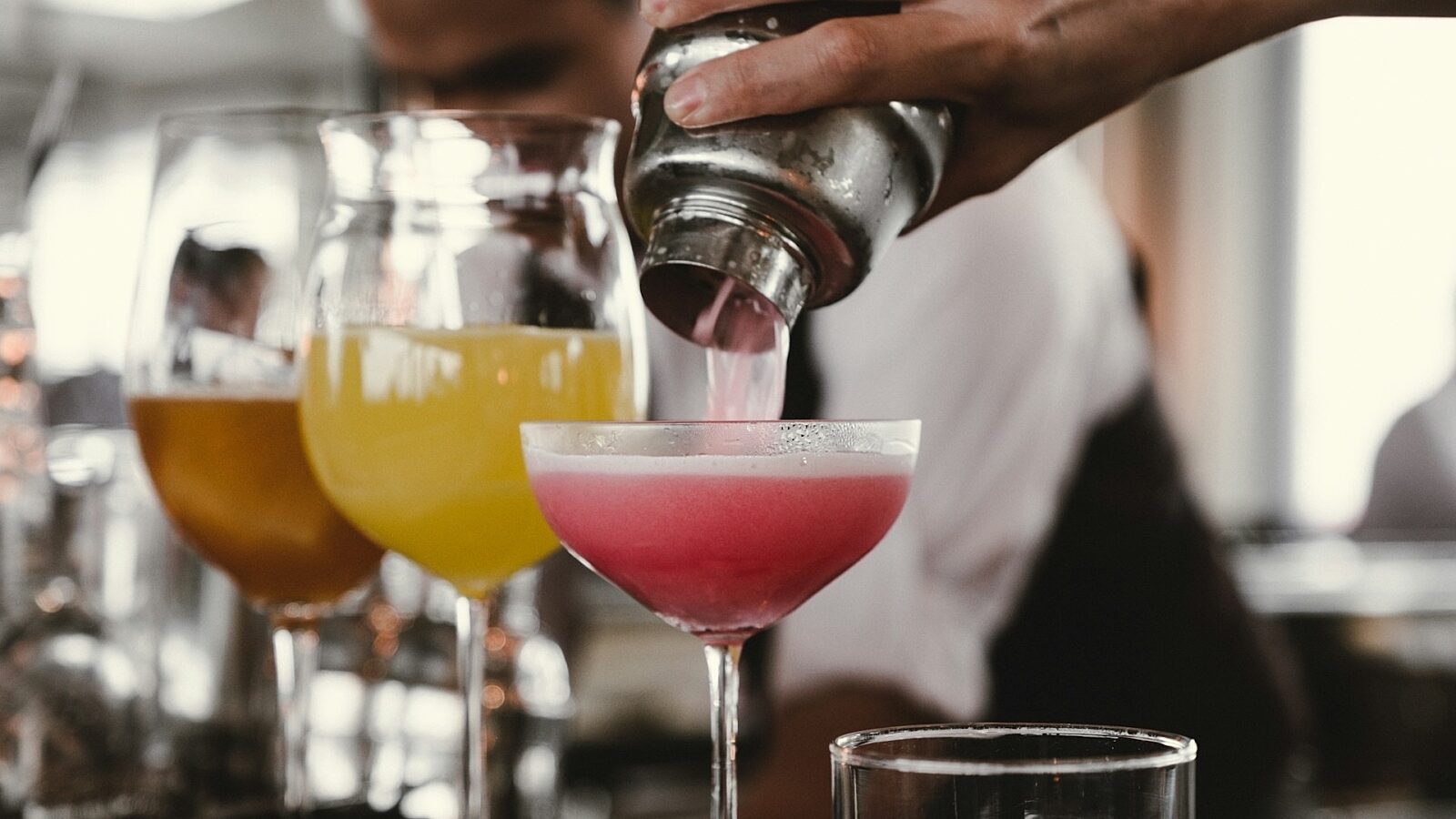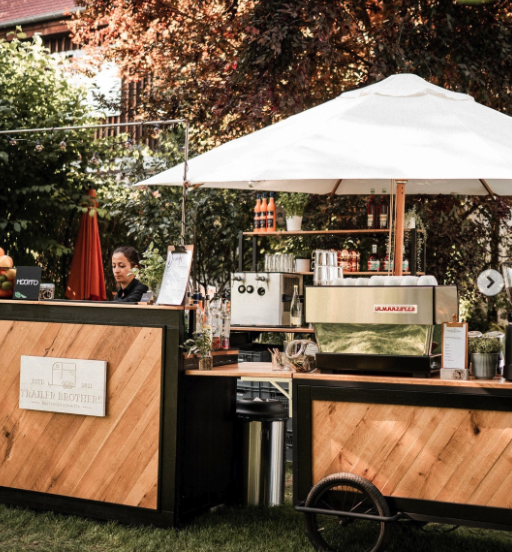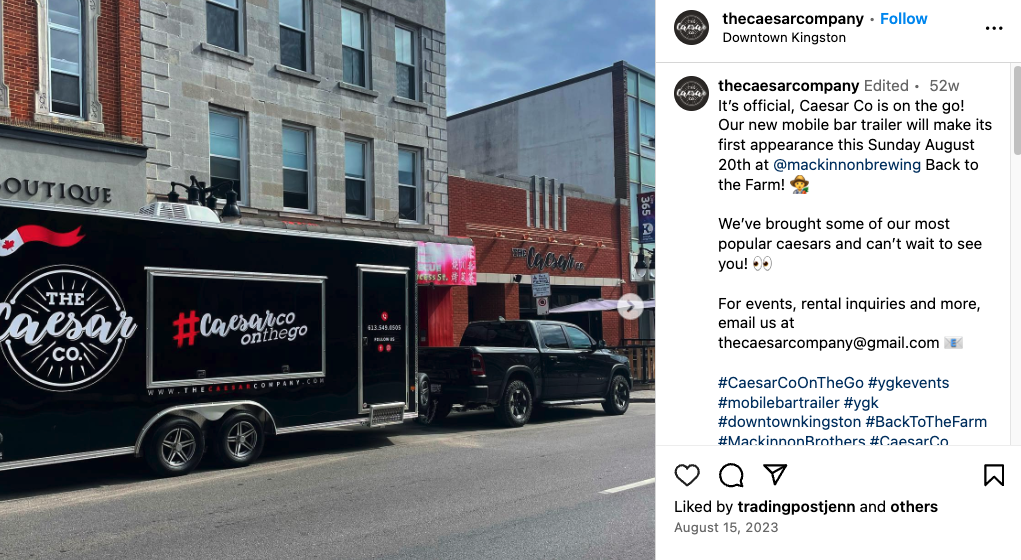
How Much Do Mobile Bars Make? (Average Mobile Bar Revenue Data 2024)
In this article, we’ll look at how you can increase mobile bar revenue and reduce costs to maximize profitability.
Aidan ToborAuthor


Opening a Mobile Bar Checklist
So many things go into opening a mobile bar. With this free PDF checklist, you'll set your new business up for success.
Get free downloadIf you’re interested in launching a mobile bar business, current industry trends bode extremely well for your potential success.
First, Expert Market Research predicts that the catering industry will grow 6% per year between 2024 and 2032. In 2023, the total market size was $72.67 billion, and data indicates it will reach $124.36 billion by 2032.
At the same time, Markets & Data projects the United States alcoholic beverages market to grow 4.95% per year from 2023 to 2030. They estimated the market size in 2022 at $175.23 billion, and predict the market size will reach $257.91 billion by 2030.
Given the growing catering and alcoholic beverage markets, now seems like the perfect time to launch a portable bar business.
However, to achieve profitability, it’s vital that you understand the financial side of running this type of business.
So, in this article, we’ll explore mobile bar revenue, costs, and profit margins. Not only will we cover how much you can expect to make, but we’ll also take a look at how you can increase revenue and reduce costs to maximize profitability.
Key Takeaways
To make more profits, it’s key to maximize revenue while minimizing expenses.
Profit margins for bartender-for-hire/open bar business models can be as high as 88%, while models where you sell each drink typically have a 20% to 40% profit margin due to increased costs.
Even though bartender-for-hire/open bar models can drive huge profit margins, actually selling each drink typically has a higher revenue potential. This can often result in higher overall profits, despite the lower margins.
The mobile bar business model that’s right for you will depend on your target market, local regulations, and other factors.
Let's dive in.
Opening a Mobile Bar Checklist
So many things go into opening a mobile bar. With this free PDF checklist, you'll set your new business up for success.

How much revenue do mobile bars make?
Before diving into the nitty-gritty of revenue optimization, let's get a sense of what portable bars typically earn.
According to Step by Step Business, the average range for annual mobile bar revenue typically falls between $52,000 and $260,000. This is equal to a monthly revenue of $4,000 and $22,000. However, it’s possible that your revenue will fall outside these figures.
For instance, if your business is new or you only operate part-time, you’ll likely fall below this range. On the other hand, if you have a well-established operation and have several employees working multiple events, you may be able to achieve even more revenue than the range above.
Generally, event organizers will pay mobile bartenders around $50 an hour, plus tips for an open bar. Better yet, they’ll pay for all of the products you serve.
Meanwhile, other events may want you to actually sell the booze, in which case you’ll have to buy the alcohol and other ingredients yourself, and then mark it up for a profit.
Regardless of the approach you take, keep in mind that demand for mobile bartending services can fluctuate a lot based on seasonality. You’ll likely experience peak demand during summer months and holiday seasons due to the increase in the number of events happening during these times.
So, it’s important to remember that you’ll likely experience some months with much higher revenue than others.
Additionally, your overall revenue potential depends on several different factors, including:
Location
Event types
Business model (for example, open bars vs. selling each drink)
Are mobile bars profitable?
Mobile bar businesses can certainly be profitable. However, to achieve profitability, you’ll need to maximize revenue while managing your expenses.
While your potential profit margins depend on several factors, one of the most important is your business model.
For instance, if you’re an owner-operator serving open bar events, you’ll be able to achieve huge net profit margins because you don’t need to pay for the cost of alcohol or staff. In fact, our analysis of costs suggests potential profit margins as high as 88%!
If your business earns $52,000 in yearly revenue, this is equal to nearly $46,000 per year, or almost $4,000 per month, in net profits.
On the other hand, if you actually purchase alcohol and then sell it for a markup, you’ll have to account for your pour cost. Likewise, as your portable bar business grows, you may need to consider additional expenses, like staffing.
Because of these extra costs, your net profit margin is more likely to fall between 20% to 40%. While this is a pretty big range, there are lots of variables that can affect potential profit margins.
Despite the lower margins, the good news for mobile bars actually selling alcohol and employing staff is that your revenue potential is much higher.
For example, if your mobile bar generates $260,000 in annual revenue, you could expect to make between $52,000 and $104,000 in yearly net profits. This is equal to about $4,300 to $8,600 in monthly net profits
Of course, these are just ballpark figures. Some mobile bars may earn less, while others, particularly those catering to high-end events or operating in lucrative markets, could see much higher numbers.
The key is to understand your market and position your business accordingly.
Restaurant Cost Control Guide
Use this guide to learn more about your restaurant costs, how to track them, and steps you can take to help maximize your profitability.

Breakdown of mobile bar costs
Now let's break down the costs associated with running a mobile bartending service. After all, understanding your expenses is crucial for maximizing profitability.
These costs can vary depending on your location, business model, and target market. For example, a high-end mobile bar might invest more in premium equipment and inventory but could command higher prices, potentially leading to better profit margins.
1. Bar equipment
Unless you have a lot of money to invest upfront, you’ll need to lease or finance your mobile bar equipment. For example, you’ll have to purchase key bar items like:
Bar tools and accessories, such as shakers and strainers
Refrigerators and ice bins
Storage and speed rails
Cutting boards
Safety gear
Portable power and water systems
Cleaning supplies
Of course, you’ll also need to purchase your mobile bar unit. While you can opt for cheaper options, like folding bars or tables with skirts, some operators may want to go with more expensive options, like modular or custom-built bars. You may even decide to go with a bar truck, which is likely the most expensive option.
Additionally, you might consider buying advanced equipment, like draft beer systems.
Ultimately, the cost of equipment can vary significantly based on the type of gear and portable bar unit you want for your business.
On the low end, you may expect to pay a total of about $5,000 for your essentials. If you finance this three-year loan at 5% interest, you would spend about $150 per month.
Meanwhile, for those purchasing a new, fully-equipped bar truck, the cost could rise to $150,000 or more.
However, you can also purchase trucks and trailers for anywhere from $20,000 to $50,000. If you finance this amount with a three-year loan at 5% interest, you would spend about $600 to $1,500 per month.
Average Monthly Cost of Leasing/Financing Mobile Bar Equipment: 3% to 10% of total revenue
2. Transportation
Of course, since you’re operating a mobile business, you also need to think about the cost of transportation. For example, you’ll face expenses such as:
Fuel
Vehicle maintenance
Transportation equipment (protective coverings, straps, dollies, etc.)
Unfortunately, this expense can be difficult to budget for due to the external factors beyond your control. For instance, you’ll need to be prepared for rises in the price of fuel, as well any potential vehicle breakdowns.
Additionally, several other factors can impact this cost, such as the distance you must travel to get to events and the number of events you participate in each month.
Lastly, unless you opt for a mobile bar truck or own a pickup truck, you may need to purchase an equipment trailer. These trailers typically cost as little as $500, or as much as $5,000.
Like equipment, the overall cost of transportation will vary quite a bit depending on your specific approach. However, it’s a good idea to aim for these expenses to amount to about 3% to 7% of total revenue.
Average Monthly Cost of Mobile Bar Transportation: 3% to 7% of total revenue
3. Liquor licenses and permits
In order to operate your mobile bar business legally, it’s crucial that you obtain the proper licenses and permits.
For example, the Pennsylvania Liquor Control Board states that you cannot operate a mobile bar business that provides alcohol. However, you can provide mobile bartending services for hire in which event hosts provide alcohol, and you simply make the drinks.
Meanwhile, Nevada’s Clark County issues “portable bar licenses to allow the retail sale of alcoholic events and locations that do not have liquor licenses” for liquor caterers.
Additionally, there are several other types of licenses and permits your mobile bartending business might require, such as:
Sales tax permits
Health and safety permits
Event-specific permits
Business license
Food Handler’s License (if you also plan to serve food)
Since regulations differ depending on state and local laws, you’ll need to do some research to ensure you have the proper documentation. You might even want to consult with a legal professional to help you navigate the laws in your area.
Average Monthly Cost For Mobile Bar Licenses and Permits: 2% to 5% of total revenue, but can vary based on local laws and regulations
4. Insurance
It’s also important that you secure several types of insurance coverage when operating your mobile bar business.
According to Mobile Bev. Pros, some of the key types of coverage you may require include:
General Liability Insurance: Protects you from claims of bodily injury, property damage, or reputational damage caused by your business
Inland Marine insurance: Protects against losses due to damaged equipment during transportation
Liquor Liability Insurance: Protects you in the event of a lawsuit stemming from over-serving alcohol to guests
Commercial Car Insurance: Protects you from accidents or damages involving your mobile bar and/or towing vehicle while in transit.
Worker’s Compensation Insurance (if you have employees): Protects you in the event that an employee suffers a work-related injury or illness.
Ultimately, the total cost of your insurance coverage depends on the types of coverage you require. Additionally, factors like your location and claims history can significantly impact your monthly premium.
According to Insurance Canopy, you can secure general and liquor liability insurance for as low as about $35 per month. However, you could spend nearly $300 per month on the high end for these types of insurance.
If you need all the types of insurance listed above, you could end up spending about $200 to $800 per month on insurance.
Average Monthly Cost of Mobile Bar Insurance: 1% to 5% of total revenue
5. Alcohol and mixers
If your mobile bartending business only focuses on open bars in which hosts provide the alcohol and mixers, you won’t need to worry much about the cost of alcohol. Depending on your arrangement with event operators, you might not even need to worry about the cost of mixers.
However, for those providing their own alcohol and charging for each drink, this will be one of your most significant expenses.
While alcohol has a much higher markup compared to other retail items, you still need to consider your pour costs. According to an analysis we conducted, the average pour cost for bars is 18% to 24%, in line with the industry standard of 18 to 20%.
This means you can expect to make a gross profit of about 78% to 80% for every drink you sell. For example, if you sell a drink for $10, your gross profit would equate to about $8.
Average Monthly Cost of Mobile Bar Alcohol and Mixers: 18% to 20%; if hosts provide the alcohol, this can drop to as little as 0%
Bar Equipment Checklist
Opening or upgrading a bar? Don't miss any essential equipment! Download our free, comprehensive Bar Equipment Checklist.

6. Disposable supplies
It’s also important to think about additional supplies you’ll need to serve your guests. For example, you’ll likely need to purchase:
Cups
Napkins
Straws
While these items are typically relatively inexpensive, it’s important to think about your brand image when determining what types of these items to buy.
For example, if your mobile bartending business emphasizes environmental sustainability, you should consider getting biodegradable cups or compostable straws. Depending on glass restrictions and your setup, you might also think about serving guests with reusable glassware.
Overall, this expense will vary based on the number of drinks you serve and the types of disposable items you purchase.
Average Monthly Cost of Mobile Bar Disposable Supplies: 2% to 5% of total revenue
7. Staff wages
If you own and operate your mobile bartending business by yourself, you obviously won’t need to worry about the cost of employee wages.
However, if you plan to be more hands-off in the daily operations or you want to expand your business, staffing will likely be one of your biggest expenses.
Depending on your local regulations, you can often pay bartenders less than minimum wage, with the expectation that tips will make up the bulk of their income. Just bear in mind that, if tips don’t meet or exceed minimum wage, you’ll be on the hook for making up the difference.
Without tips, the average bartender salary in the United States is about $26,000. So, a mobile bar with $260,000 in annual revenue and one employee that relies on tips would have a labor cost percentage of 10%.
On the other hand, you might also choose to pay your employees a standard wage and avoid the uncertainty of tips. This is likely a better option for open bar models, where guests may not bring money for tipping.+
The average bartender makes about $60,000 after accounting for tips. So, for a mobile bar generating $260,000 in annual revenue to offer this wage to one employee would result in a 23% labor cost.
Of course, you can also pay employees a standard wage in addition to letting them accept tips.
Ultimately, it’s key to take some time and think about the approach that works best for your specific business.
Average Monthly Cost of Mobile Bar Staff Wages: 10% to 25% of total revenue; 0% if you own and operate your business by yourself
8. Payment processing
For mobile bars selling alcohol, payment processing fees are another expense to consider. Generally, you can expect to pay about 2.5% to 3.5% for each transaction.
For example, if you sell a drink for $10, you typically pay about 25 to 35 cents in order to process the guest’s credit card or mobile wallet payment.
While you can avoid this cost by only accepting cash, this can significantly limit guests’ ability to buy your drinks. This would likely result in a lot of missed revenue.
Meanwhile, mobile bartenders for hire often don’t need to worry about payment processing fees, especially if they accept checks. However, depending on how you decide to accept payment from event hosts, you might still incur a small transaction fee.
Average Monthly Cost of Mobile Bar Payment Processing: 2.5% to 3.5% of total revenue; potentially as low as 0% if you don’t actually sell drinks
9. Marketing and advertising
One more cost to think about for your mobile bar is marketing and advertising. This is key to finding new clients and driving more revenue for your business.
Generally, you’ll likely want to spend about 1% to 5% of your total revenue on marketing. However, by providing an excellent experience, you may be able to drive more word-of-mouth referrals and repeat gigs, which can reduce the amount you need to spend.
You can also make use of free forms of marketing, like building your social media presence and showcasing the positive vibes you bring to events.
However, as you get started, you may need to spend more money on advertising so new potential customers can find your business. For example, you may want to experiment with paid ads or giveaways.
Ultimately, it’s a good idea to experiment with different forms of marketing and advertising to learn what works best.
Total Monthly Cost of Mobile Bar Marketing and Advertising: 1% to 5% of total revenue
How to reduce mobile bar costs
Now that you have a good understanding of the costs involved in operating a mobile bar business, let’s take a look at some strategies for reducing your expenses.
By using these tactics, you can lessen your total spend and take home a larger profit margin:
Bulk Purchasing: Buy frequently-used items in larger quantities to reduce per-unit costs.
Efficient Scheduling: Carefully plan your events to minimize travel time and maximize the number of events you can serve.
Smart Inventory Management: Use inventory tracking software to reduce waste and prevent overstocking.
DIY Maintenance: Learn to handle minor vehicle and equipment repairs yourself to save on maintenance costs.
Remember, while cutting costs is important, it shouldn't come at the expense of quality. Your goal should be to find efficiencies without compromising the customer experience.
How to increase mobile bar revenue
Of course, reducing expenses isn’t the only way to increase your profits. You should also consider how you can increase your mobile bar revenue.
Below, we discuss some of the best strategies for boosting revenue and maximizing your net profit margin.
1. Shake up your marketing
Effective marketing is crucial for attracting customers and standing out from the competition.
To reach potential customers where they are and promote yourself as the best option for their private parties, consider these strategies:
Social Media: Showcase your mobile bar in action with eye-catching photos and videos on platforms like Instagram and TikTok.
Local Partnerships: Team up with event planners, wedding venues, and other businesses in the events industry for cross-promotion opportunities.
SEO: Ensure your website ranks well for local searches related to mobile bars and event services.
Email Marketing: Build a mailing list to keep past customers informed about special offers and new services.
Additionally, networking and talking to new people can be an excellent way to drum up more business. In an interview with Voyage Austin, Shay Gonzales, owner of the mobile bar Too Shay Spirits, said:
“At the end of the day, networking is also key. It’s just me at Too Shay Spirits, so any opportunity to discuss my business is a win for me. You never know who you are going to meet in Austin, so always be open to sharing what you’re passionate about if given the opportunity. Since I still work at a restaurant five days a week, I use those days to connect with guests and share what I do. People are always throwing events!”
2. Tap into technology
Embracing technology is vital for streamlining your operations, as well as enhancing the guest experience.
So, be sure to consider integrating these tech tools into your mobile bar business:
Point-of-sale (POS) Systems: Use mobile POS systems to process payments quickly and track sales data.
Inventory Management Software: Implement digital tools to monitor stock levels and automate reordering.
Online Booking Systems: Allow customers to book your services and make deposits online for convenience.
Route Optimization Apps: Plan the most efficient routes between events to save time and fuel.
3. Mix in premium products
Upselling and offering premium options can significantly boost your average order value. For example, think about using these strategies to increase your sales without overserving guests:
Craft Cocktail Menus: Develop a selection of unique, Instagram-worthy cocktails that command higher prices.
Top-Shelf Spirits: Offer premium liquor options for discerning clients willing to pay more.
Non-Alcoholic Alternatives: Stock high-quality mocktails and artisanal sodas for non-drinkers.
Customization Options: Allow customers to create signature drinks for their events at a premium price.
Guide to Restaurant Social Media Marketing
Learn how to optimize your social media presence to showcase your brand, tell your story, attract new customers, and engage with your audience.

4. Keep your customers coming back
Repeat business is often more profitable than constantly chasing new customers. After all, this can reduce your marketing spend and drive consistent sales.
So, try these strategies to increase customer frequency:
Loyalty Programs: Offer incentives for repeat bookings or referrals.
Seasonal Specials: Create limited-time offerings to encourage repeat business throughout the year.
Follow-Up Marketing: Send personalized thank-you notes and special offers after events.
Diversify Your Services: Consider offering bartending classes or mixology workshops during slower periods.
Grow your mobile bar business with revenue modeling
As you implement revenue-boosting strategies and watch your business grow, it's crucial to keep your expenses in line with your sales. This is where revenue modeling comes in handy.
Revenue modeling involves creating financial projections based on historical data and future expectations. Here's a simple process to get started:
Analyze Past Performance: Look at your revenue and expenses from previous months and years to identify trends.
Set Realistic Growth Targets: Based on your market research and business strategies, set achievable revenue goals for the coming months and years.
Project Expenses: Estimate how your costs will change as your revenue grows. Remember that some expenses (like inventory) will increase proportionally with revenue, while others may remain relatively stable.
Create Scenarios: Develop best-case, worst-case, and most-likely scenarios to help you prepare for different outcomes.
Regularly Review and Adjust: Compare your actual results to your projections monthly or quarterly, and adjust your model as needed.
By keeping a close eye on your revenue model, you can make informed decisions about when to invest in new equipment, hire additional staff, or expand your services. This will set your mobile bar business up for long-term growth and success.
Grow mobile bar revenue and reduce costs to maximize profits
Remember, success in the mobile bar business requires a balance of financial savvy, creative flair, and a genuine passion for hospitality.
By understanding your revenue, costs, and profit margins, you can create a mobile bar business that not only survives, but thrives.
Of course, to streamline your operations and enhance your guest experience, it’s key that you have the right tools. Fortunately, with a comprehensive POS system, you can easily process payments, track inventory, and much more!
To discover all the ways a POS system can help you run a better mobile bar business, be sure to check out all of Toast’s awesome features.
Related Resources
Is this article helpful?
DISCLAIMER: This information is provided for general informational purposes only, and publication does not constitute an endorsement. Toast does not warrant the accuracy or completeness of any information, text, graphics, links, or other items contained within this content. Toast does not guarantee you will achieve any specific results if you follow any advice herein. It may be advisable for you to consult with a professional such as a lawyer, accountant, or business advisor for advice specific to your situation.
Subscribe to On the Line
Sign up to get industry intel, advice, tools, and honest takes from real people tackling their restaurants’ greatest challenges.




